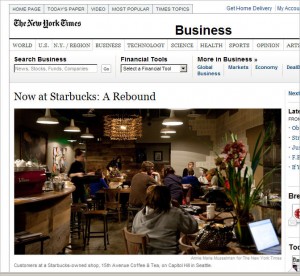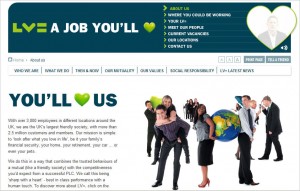Okay—pun intended. But blame the New York Times for introducing basketball in its recent story titled Now at Starbucks: A Rebound. In its Q1 earnings report, SBUX showed a net income of $241.5 million (up from $64.3 million in the year-ago quarter), revenue up 4%, and same-store sales up 4%. After several quarters of steady declines, the new view must look just like heaven.
So what has Starbucks done right? First let’s consider how this connects with the subject of Careers.
Back in May of 2008, when Starbucks was still assumed to be bullet-proof, HR guru Kevin Wheeler wrote an article about employer branding titled Why Google or Starbucks? In it he wonders what makes people especially eager to work at certain companies, and decides: “More people are attracted to causes than things.”
We could argue whether this is still true in times (like now) of high unemployment. But let’s say for the moment that Wheeler’s proposition is at least basically true. He sees Google’s “cause” as free information, and asserts that:
Starbucks’ cause is community. It’s a place, like in the old television show Cheers, where everybody knows your name. It feels good to go into your local Starbucks every morning, be greeted by a smiling barista who knows your name and your favorite drink, and to meet some friends.
That is indeed the role Starbucks plays in my life, and in spite of corporate ups and downs, my local baristas are always warmly waiting when I walk in the door—and I regard every Starbucks location as a remote office plus home-away-from-home. But even when Wheeler was writing, SBUX was in trouble. That same year saw the beginning of extensive store closings and layoffs, along with a barrage of downside publicity.
To the extent that their reinvention campaign is succeeding, it’s not only because of streamlining or process improvements. There has also been a focus on reenergizing employees—and Starbucks has joined the new culture of customer engagement: lots of social networking, a listening campaign, special offers, and even an affiliation with MSNBC’s feisty AM talk show, Morning Joe.
The Starbucks Career Center website now reads like an excerpt from Wheeler’s article. The headline: “It’s a lot like working with friends.” And the pitch:
We call each other “partners”. We respect our customers and each other. We’re dedicated to serving ethically sourced coffee, caring for the environment and giving back to the communities where we do business. And we’re still small enough to remember your name when you walk in the door.
Reinforcing the message is a festoon of employer awards, from the trusty Fortune 100 Best Companies to Work For to Forbes 100 Best Corporate Citizens and Best Places to Work for LGBT Equality. So the “cause factor” is definitely full court press.
Not that everything is perking perfectly in the inner world of Starbucks. There are employee complaints—and because Starbucks is big, and actively represents itself as a responsible employer, those complaints get coverage. But the percentage of unhappy workers seems proportional, and there is definitely no lack of barista wannabes.
Now for the punch line. If you compare Keven Wheeler’s prescription for establishing a strong employer brand with NYT’s account of what’s behind the Starbucks rebound . . . there is a very strong similarity. Wheeler’s five steps to “Make Your Company Memorable”:
- Gain perspective and know yourself.
- Define the promise.
- Develop a strategy.
- Create a “buzz” to communicate your brand.
- Measure your progress.
In short—what works for getting and keeping employees works for getting and keeping customers. And vice versa.


